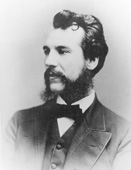Lesson 1
1. Lesson 1
1.4. Discover
Module 1: Probability

© RTimages/6986221/Fotolia
Discover
How do you make decisions? Some decisions can be made quickly, while others need time for deliberation.
Think of a difficult choice that you have had to make recently. It might have involved choosing a cellphone, a transportation method, a computer, the date and destination for a vacation, a school, and so on.
How did you make the decision? Perhaps your decision was based on facts and information, prior knowledge, assumptions, and observations, or maybe you used your emotion or intuition.
Looking back, did you make the right decision? If you could change it, would you and why?

Photos.com/Thinkstock
In 1876, William Orton, President of the Western Union Communications Company, was approached by Gardiner G. Hubbard, an investor in a recent communication invention to buy a patent (No. 174,465) for $100 000. At that time, the Western Union had a monopoly on the market because of their most advanced telegraph communications technology. Orton appointed a committee to investigate the offer. After careful consideration, he decided to turn the offer down, referring to the patented device as a novelty toy that they had no use for.
The patent was for the telephone, invented by Alexander Graham Bell. Bell kept the patent and in a few decades, he had the largest communication corporation in America.
Try This 1
It is difficult to make decisions that affect the outcomes of the future. Making logical predictions based on data would certainly make decision making easier! Test your predicting abilities in the following activity.
Open Dice Roller and use it to answer the following questions.
- Does each number on the green die have an equal chance of appearing when rolled?
- Predict how many times each number will appear on the green die in 6 rolls. Explain your reasoning.
Roll the die 6 times and record the results from the green die in a table like the one shown.
Outcome
Tally
1
2
3
4
5
6
Total
- Did the results show that each number appeared once when the green die was rolled 6 times?
Now roll the die 6 more times and continue recording the results from the green die in your table.
-
How many times would you expect each number to appear after rolling a die 12 times?
- From your results, are there any numbers on the die that have not yet appeared?
Roll the die 6 more times and continue recording the results from the green die in your table.
By now, you should have rolled the die a total of 18 times. Complete your table by adding a frequency column as seen in the hint. Once you are finished rolling the die, fill in the frequency column of your table. Your table should have 18 rolls of the green die.
![]() Save your responses in your course folder.
Save your responses in your course folder.
Share 1
With a partner or in a group, share the results of your table and responses to the previous questions.
- Were the frequencies of the outcomes the same? Explain.
- Create a new table containing the combined results from your partner’s table or each group member’s table. Determine the sum of the frequency column. What does that number tell you?
- From this new table, how many times would you expect any particular number to occur? Is this the same for each number 1 through 6?
- Describe a way you could numerically represent the likelihood of a 2 occurring when you roll a standard 6-sided die once.
![]() Save your shared responses in your course folder.
Save your shared responses in your course folder.
Outcomes are the list of events that are possible when a die is rolled. A tally is a list of ticks or checks that represent the number of times an outcome occurs. Frequency is the numerical representation of the tally. An example of what the table may look like after rolling the green die six times is shown.
Outcome |
Tally | Frequency |
1 |
l l | 2 |
2 |
0 |
|
3 |
l | 1 |
4 |
l l l | 3 |
5 |
0 |
|
6 |
0 |
